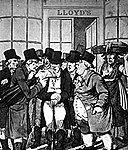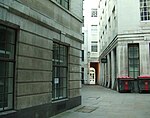Lombard Street, London
History of bankingStreets in the City of LondonUse British English from November 2014

Lombard Street () is a street notable for its connections with the City of London's merchant, banking and insurance industries, stretching back to medieval times. From Bank junction, where nine streets converge by the Bank of England, Lombard Street runs southeast for a short distance before bearing left into a more easterly direction, and terminates at a junction with Gracechurch Street and Fenchurch Street. Its overall length is 260 metres (280 yd). It has often been compared with Wall Street in New York City.
Excerpt from the Wikipedia article Lombard Street, London (License: CC BY-SA 3.0, Authors, Images).Lombard Street, London
Lombard Street, City of London
Geographical coordinates (GPS) Address Nearby Places Show on map
Geographical coordinates (GPS)
| Latitude | Longitude |
|---|---|
| N 51.5125 ° | E -0.0869 ° |
Address
UBS
Lombard Street
EC3V 9AH City of London
England, United Kingdom
Open on Google Maps









